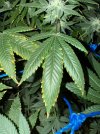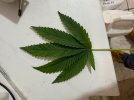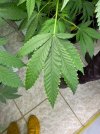"I’ve always used Remo according to the stock feed chart, and with HPS I never had any nutrient deficiencies or excesses while keeping the EC in this range.
This is my third cycle facing the same issue. I’ve already tried changing the substrate, lowering the LED panel intensity, and even switching to different nutrients, but the result is always the same."
By a process of elimination, you're finding the things that don't work. Would that I were so patient.
The chart below shows VPD at a variety of temps. At 72° and RH 55% with a leaf temperature offset of -2°F, your VPD is 1.0. That's a significant reduction in transpiration from 1.3 (25%). If you were using HPS previously, your leaf temps were significantly higher which raised VPD and that increased the rate of photosynthesis. 72° is pretty chilly for cannabis, even in flower.
Couple the low temp with only 550µmol and you have very slow growing plants. An EC of 2.2 in flower might be suitable for cannabis under HPS but, with the low leaf temps, you're now proving, for the third time, that it's too high. The combination of low temps and low PPFD call for reduced EC.
Light is how a plant generates glucose, which is uses for food. In addition to sugars, the plant requires the chemicals in nutrients for respiration and growth. They have to work in roughly similar levels for the plant to thrive. When you're proving EC 2.2 in a low VPD, low light environment the result is that you have plants that are getting a lot of nitrogen and are starting to show nutrient imbalances.
The steps that I would take to bring things back into balance:

Why do you want to use a PPFD of 500-600µmol?
If you want to keep your light at that level, reduce your EC. I can't think of a reason to use 550µmol unless you want to use an LED grow light to mimic the output of an HPS light. A cannabis plant, in a sound environment, will thrive on 500-600µmol by week 2-3. There's no argument that you can get a crop at 500-600 but if you want to use that amount of light with LED your plants will benefit by adjusting other parts of your grow environment to compensate.
Another issue is temperature. At 72°, your rate of photosynthesis is very low. The graphic below is from "the Chandra paper" (attached) which many growers mistakenly glommed on to because they thought it made the argument that there's little value in using >600µmol for cannabis. That's an invalid assumption, as all research on light levels on cannabis have shown.
What's interesting about your grow is that you're supplementing CO2, which is great for increasing the rate of photosynthesis, but your low temps are constraining growth. Take a moment to review the chart and you'll see the impact.
The increased CO2 level is resulting in increase photosynthesis but it's markedly below the rate of photosynthesis that you would be getting by increasing the temperature.
The crop yield curve for cannabis does not match the diminishing returns that Chandra documents for net photosynthesis. Careful reading of the paper reveals that the rate of photosynthesis was for individual leaves that were harvested and tested in a small chamber. The data are taken to be correct but it's completely erroneous to conclude that cannabis yield exhibits the same curve. It does
not and, if you read the paper
at this link, a group of researchers at Guelph (a school with a good reputation for STEM in Ontario, CA) discuss that they undertook their research to deal with that very issue.
I suspect that the increase in photosynthesis helps offset reduction that the cooler temperature causes, so your EC levels aren't that far off. Perhaps it would be beneficial to drop EC by 10-20% and see how the plants react.
That is a band aid, though. If you've got the ability to enhance CO2 levels, it seems a shame to provide you plants with such a limited amount of light and keep them at only 72°. Per my earlier posting, tending to those two issues has the potential to cause a vast increase in yield.

 WhatsApp Image 2025-08-15 at 21.24.44 (1).jpeg198.7 KB · Views: 17
WhatsApp Image 2025-08-15 at 21.24.44 (1).jpeg198.7 KB · Views: 17 WhatsApp Image 2025-08-15 at 21.24.44 (2).jpeg327.1 KB · Views: 15
WhatsApp Image 2025-08-15 at 21.24.44 (2).jpeg327.1 KB · Views: 15 WhatsApp Image 2025-08-15 at 21.24.44.jpeg342.4 KB · Views: 14
WhatsApp Image 2025-08-15 at 21.24.44.jpeg342.4 KB · Views: 14 WhatsApp Image 2025-08-15 at 21.24.45 (1).jpeg145.6 KB · Views: 16
WhatsApp Image 2025-08-15 at 21.24.45 (1).jpeg145.6 KB · Views: 16 WhatsApp Image 2025-08-15 at 21.24.45 (2).jpeg154.5 KB · Views: 16
WhatsApp Image 2025-08-15 at 21.24.45 (2).jpeg154.5 KB · Views: 16 WhatsApp Image 2025-08-15 at 21.24.45.jpeg288.9 KB · Views: 16
WhatsApp Image 2025-08-15 at 21.24.45.jpeg288.9 KB · Views: 16

